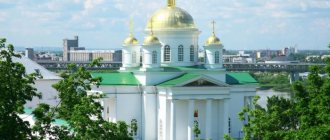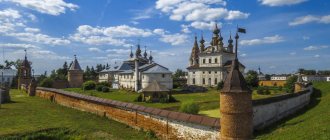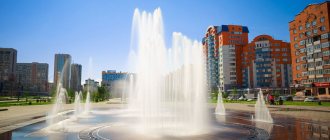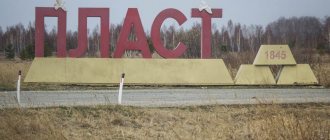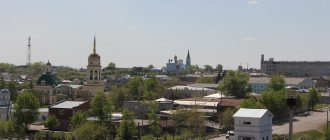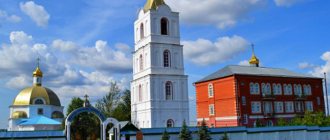Where is Novosibirsk located?
Novosibirsk (formerly Novo-Nikolaevsk) is the administrative center of the Siberian Federal District. The city is located in the southeastern part of the West Siberian Plain on the banks of the Ob River next to the artificial Novosibirsk Reservoir, formed in the late 1950s during the construction of the Novosibirsk Hydroelectric Power Station.
Novosibirsk is the third most populous city in Russia after Moscow and St. Petersburg and the largest in the Asian part of the Russian Federation. Novosibirsk belongs to the time zone MSC+4 (Krasnoyarsk time), the UTC offset is +7:00. You can find out the exact time in Novosibirsk on the TimeServer.ru website.
Novosibirsk
© Olga Klein
Initially, Nikolsky Pogost was located on the territory of the now existing city. Some time later it was renamed the village of Krivoshchekovo. It was located on the left bank of the river, between 2 bridges - Dmitrovsky and Oktyabrsky. Somewhat later, in 1893, the village already had its own primary school and steamship pier. Its population was 685 people. Due to the fact that the Great Siberian Road (as the Trans-Siberian Railway was originally called) was to be built on the site of the existing village, residents at some point were forced to move to nearby settlements, since it was clear that the village would soon be destroyed.
Some of the former villagers chose the right bank of the river, also called the Devil's Settlement, as a new place to live. It should be noted that this place did not have the best reputation, to put it mildly. Near it, not far from the mouth of the Kamenka, there was a village called Mochigu. The population here was predominantly indigenous, not known for their friendliness. The aborigines preserved the remains of the Teleut fortress. Before its destruction, this structure stood proudly above the terrain below. However, the former residents of the destroyed village were not frightened by the notoriety of their new place of residence, and they very quickly established themselves here.
The newly formed village was named Krivoshchekovsky Vyselok. It was this event that became the beginning of a new history for the right bank. In the spring of the same year, workers arrived in the new village to build a village necessary for the residence of those who built the bridges. This day is officially considered the founding day of the city. In the northern part, construction of a village began, and with it a railway station. Upon completion of construction, both villages will be united into 1 large-scale settlement.
In the winter of 1903, Nicholas II issued a decree that Novo-Nikolaevsk, located near the Ob railway station, should be elevated to the rank of a city without a district. The decree was signed personally by Rydzewski, the manager of the royal cabinet.
In the spring of 1909, the largest fire in terms of its scale occurred in the newly formed city, which could not be extinguished for several days. Its consequences were terrible for the townspeople. It destroyed almost 800 residential buildings and adjacent buildings. 22 city blocks and many important objects were destroyed. This event caused more than 6,000 city residents to become homeless. They were now forced to live in a camp along Kamenka. The damage from the disaster described above amounted to more than 5,000,000 gold rubles. But the troubles for the city and its residents did not end there. Just a couple of days later the city was engulfed in a typhus epidemic.
© Olga Klein
Another 3 years later, in 1912, primary education in the city was legalized at the state level. Before this, it was official only in Yaroslavl. In parallel with this, a project to ensure communication between Altai and Siberia was legalized in St. Petersburg. It was planned to use the railway as the main means of communication. A variety of towns and cities were considered as possible variations of the departure point. However, the city leadership, represented by V. Zhernakov, was able to convince the commission that the point should be opened in Novo-Nikolaevsk. In the summer of the same year, the corresponding project was approved. So Novo-Nikolaevsk, and now Novosibirsk, turned from a small village into a large multimodal hub. These events became the impetus for the future intensive development of the city in terms of economics. In 1915, there were already 7 banks here, and the population increased more than 11 times, approaching 70,000 people. The railway was not yet completed at that time. The symbol of that time in the history of the city is the Chapel of St. Nicholas, opened in the same year on Krasny Prospekt.
A year later, the city was given the status of a provincial city for the Altai province that was being formed at that time. It was planned to complete its creation in 2 years. However, soon the status of a provincial city, by decision of the temporary authorities, was transferred to Barnaul.
Airport
Novosibirsk Tolmachevo International Airport is the largest in Siberia in terms of passenger traffic (5.9 million passengers per year as of 2018). The airport has been awarded Platinum status by the International Air Transport Association IATA, which confirms 100% implementation of technologies to simplify airport formalities. Tolmachevo is also the 4th airport (after Domodedovo, Sheremetyevo and Pulkovo) to introduce 2D barcode encoding technology for boarding passes (BCBP).
Tolmachevo is a hub for three airlines - Russian S7 Airlines (main hub) and NordStar, as well as German Lufthansa Cargo (Lufthansa's cargo division). The air harbor not only serves civilian ships, but also military aircraft of the Russian Air Force are based (562 air base, covered from the ground by the 41st Air Defense Division).
Novosibirsk International Airport is located 17 km from the center of Novosibirsk on the outskirts of the city of Ob. There are buses and minibuses from the city to the air harbor, as well as regular trains running along the Trans-Siberian Railway; the nearest station is located 1 km from the airport.
From Tolmachevo Airport there are flights to many cities in the European and Asian parts of Russia. International flights operate to a large number of countries, including Germany, Spain, China, Vietnam, Thailand, Turkey, UAE, etc.
Story
After the October Revolution, the city began to be called Novonikolaevsk, and in 1925 it was renamed Novosibirsk.
With the construction of the Trans-Siberian Railway and the bridge across the Ob, the city became a major transport hub. After the revolution it becomes a major administrative center of Siberia. Novonikolaevsk became the head of the province. In 1925, the city became the center of the Siberian Territory, which was formed from the Altai, Yenisei, Irkutsk, Novonikolaevsk, Omsk and Tomsk provinces. Later, 2 regions were formed from it: East Siberian, with the center in Irkutsk, and West Siberian, with the center in Novosibirsk. During the Great Patriotic War, factories from the European part of the country were evacuated to the city of Novosibirsk and it became a major industrial center. Over the 70 years of its history, the population has increased to a million people, and the city of Novosibirsk has turned into a metropolis.
Since 2000, the city of Novosibirsk has become the center of the Siberian Federal District. The Novosibirsk Academic Town is widely known - one of the largest scientific and educational centers in Russia. It is located 20 km from the city center. Here is the Novosibirsk State University, research institutes, and the Presidium of the Siberian Branch of the Russian Academy of Sciences.
Railway stations of Novosibirsk
The main passenger railway station, Novosibirsk-Glavny, is one of the largest in Russia with passenger traffic of about 16 million people per year. Trains depart from the station to a large number of directions - many large and small cities of Russia, to neighboring countries (Ukraine, Belarus, China, Kazakhstan, Uzbekistan, Mongolia).
There are other railway stations in Novosibirsk, but with less passenger traffic (they all have connections with the main station):
- Novosibirsk-Yuzhny.
- Novosibirsk-Zapadny.
- Novosibirsk-Vostochny.
- Station with the Seyatel station.
The Inskaya marshalling station, located within Novosibirsk (Pervomaisky district), is of great importance for the country as a whole. Railway lines from Kuzbass, the Urals and Central Asia converge here. At the marshalling yard, more than 27 thousand cars are unloaded/loaded in just one day.
Unpretentious capital
Recently, many high-rise buildings have been built, but they are trying to build comfortable housing and convenient business centers. The entire remodel fits quite organically into the image of the city, recognizable and loved. A great variety of administrative, financial and trade organizations do not overshadow, however, the working and cultural glory of Novosibirsk.
There is enough of everything here, and people come to live with pleasure. People from the southern and Caucasian republics are trying to dilute the Russian-Tatar-Ukrainian community There's enough room for everyone for now.
To have a complete picture of the city, you need to visit:
- parks and squares of the central part;
- the Ob embankment with a color and musical fountain;
- Akademgorodok;
- zoo;
- at least one of the theaters or sports facilities.
The list of attractions can be continued, but for me it’s always enough to see my family, friends from school and university, and just wander the streets. The largest and most beautiful city in Siberia welcomes all guests , and especially its natives.)))
Bus stations of Novosibirsk
In Novosibirsk, at the time of writing this article, there was one large bus station in the city center (Krasny Prospekt, 4), the main building of which was under reconstruction. Instead of the central bus station, there are small bus stations in different parts of the city, from where buses travel along a variety of suburban and intercity routes, as well as to some cities in the near abroad.
It is planned to open several bus stations on the outskirts of Novosibirsk soon, which can be reached by regular city buses and minibuses.
Metropolitan
The Novosibirsk metro is the easternmost in Russia, the only one beyond the Urals and in Siberia as a whole. Consists of two intersecting lines, 13 passenger stations, covering only 6 of the 10 districts of the city.
An interesting fact is that the Novosibirsk metro system claims to be the most extreme in the world due to the fact that in some areas the temperature drops below zero degrees.
The Novosibirsk metro is the third busiest in Russia, behind Moscow and St. Petersburg. About 80 million people use it annually.
Novosibirsk in facts and figures
Novosibirsk is located in the continental climate zone. The average air temperature in January is -19 °C, in July +19 °C. The lowest temperature recorded in 1915 was 51 °C below zero, the highest was +40 °C.
Novosibirsk is the largest metropolis in Siberia and one of the largest municipalities in Russia.
The city is the unofficial capital of Siberia, its influence covers an area of more than 5 million square meters. km is 30% of the territory of Russia, with a population of more than 20 million people, which is 14% of the population of Russia.
In 2000, by decree of the President of the Russian Federation, the Siberian Federal District was formed, with Novosibirsk designated as its center.
The settlement, which later became the city of Novosibirsk, was founded in 1893 on the site of the construction of a railway bridge across the Ob River.
The ancient railway bridge has now been dismantled, and its parts are displayed on the banks of the Ob River in memory of this structure. Novosibirsk is the third most populous city in Russia. The permanent population according to 2007 data is 1391.9 thousand people. In fact, about 2 million people live in Novosibirsk.
Among millionaire cities, Novosibirsk is the fastest growing. To reach the milestone of a million inhabitants, it took Moscow 700 years, Tokyo - 400, New York - 250, Chicago - 90. Novosibirsk passed this path in just 70 years.
The city covers an area of about 503.1 square meters. km. In terms of area occupied, Novosibirsk ranks third in Russia, second only to Moscow and St. Petersburg. From north to south the city stretches for 43 km. The latitudinal diameter is more than 25 km. The city has more than 1,500 streets, their total length is 1,400 km.
Novosibirsk is the largest transport hub in Siberia: the Trans-Siberian Railway, railways and highways pass through it. The administration of the West Siberian Railway is located in Novosibirsk, which ranks first in the country and in the world in terms of traffic volume.
There are 4 railway stations in the city, of which the Novosibirsk-Glavny station is the largest beyond the Urals.
Novosibirsk International Airport ranks third in terms of traffic volume after the airports of Moscow and St. Petersburg.
Novosibirsk is the first and so far the only city in Siberia to have a metro system (since 1985). Currently, two of its lines are operating, consisting of 13 stations.
The longest metro bridge in the world is located in Novosibirsk - its length together with the coastal overpasses is 2145 m. The Novosibirsk metro carries more than 300 thousand passengers per day - this is the third figure in the country after the Moscow and St. Petersburg metro.
The area of the Ob River basin on which the city stands is about 3 million square meters. km. According to this indicator, the river ranks first in Russia. The Ob is also the third most water-bearing river in Russia after the Yenisei and Lena.
Novosibirsk Academy Town is known throughout the world. It became the country's first comprehensive scientific center and served as a model for a number of organizations created in other countries.
In total, there are 47 higher educational institutions in Novosibirsk. Of these, 14 universities, 23 institutes, 10 academies. The largest university is Novosibirsk State Technical University, where more than 22 thousand students study.
Novosibirsk is home to the largest in Siberia and one of the largest libraries in the world - the State Public Scientific and Technical Library of the SB RAS, with a collection of approximately 14 million volumes.
The city ranks first after Moscow and St. Petersburg in terms of telecommunications equipment, and the residence of the vice-president of the INTEL corporation, who lives and works in Akademgorodok, is comparable to the Pentagon in terms of promising developments, the level of its technical equipment and information security system.
Novosibirsk is a large industrial center. The industrial complex is based on 194 large and medium-sized industrial enterprises. They account for 84% of all industrial production in the city and 74.1% of the regional one. The basic industries are mechanical engineering, electric power, metallurgy and food industry.
Novosibirsk ranks 4th in Russia (after Moscow, St. Petersburg and Yekaterinburg) in terms of retail turnover.
The material was prepared by the online editors of www.rian.ru based on information from open sources
Automobile highways
Six main highways pass through Novosibirsk:
- Federal highway P254 to Omsk.
- Highway P255 to Tomsk, Kemerovo and Krasnoyarsk (federal highway "Siberia").
- Route 50K12 of regional significance to Kolyvan, Tomsk and Kolpashevo.
- Federal highway P256 (Chuysky tract) to Barnaul, Biysk and Gorno-Altaisk.
- Highway P380 of regional importance to Ordynsky, Kamen on the Ob and Pavlodar.
There are three bridges across the Ob River - Bugrinsky, Oktyabrsky and Dimitrovsky. These are the most picturesque sections of roads within the city.
What is Novosibirsk famous for?
Novosibirsk is a Siberian city, so most Russian citizens and tourists unfamiliar with it automatically associate it with frosts, bears walking freely through the streets, taiga and, of course, pine nuts. Some Russians call Novosibirsk the capital of all Siberia and associate it with Akademgorodok, where dozens of scientists came from, some of whom achieved world fame.
For the residents themselves, Novosibirsk is much more than any stereotypes about it. Just look at the Ob River, which is one of the largest in the world (its length is 5410 km - the 7th longest in the world).
The Academic Town of Novosibirsk is the largest scientific and educational center in Russia, on the territory of which dozens of research institutes operate. Since 2014, Akademgorodok has been included in the register of objects of cultural significance. There are a large number of attractions on the territory of the city, one of which is the building of the Novosibirsk-Glavny railway station, designed in the form of a rushing train, which greets guests immediately upon arrival in the city.
Other information about the location of Novosibirsk
The geographical location of the capital of the Novosibirsk region is also determined by its location in the continental climate zone, where the average annual temperature is 1.8°C. The average winter temperature in Novosibirsk is minus 16°C, and the summer temperature is plus 19°C. Moreover, the cold weather record was recorded in the city back in January 1915, when the thermometer dropped to minus 51.1°C, and the maximum on June 7, 1967 was plus 36.6°C. At the same time, the average annual number of hours of sunshine in Novosibirsk is 2077.
Until the 90s of the last century, the capital of the Novosibirsk region was part of the so-called seventh time zone, which sometimes led to very curious cases. Thus, the flight from Tolmachevo to Novosibirsk airport took about 4 hours, and takeoff and landing took place at the same time. After the 90s, the city was moved to the sixth time zone or the so-called Omsk Time Zone (OMST), as a result, the time difference in it began to be 3 hours and 6 hours from the “zero mark” of time calculation. But the changes did not end there, and on March 27, 2011, Novosibirsk was returned to the old time, and Moscow was “moved” an hour forward, as a result of which the difference of 3 hours remained the same.




